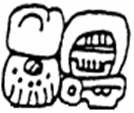

K&L.p26.#2.1&2 TOK.p19.r3.c1 = BMM9.p16.r2.c1
K’AB K’AB K’AB
· No glyphs given in K&H.
· Features:
o Left hand viewed from the palm of the hand, with fingers outstretched, pointing right.
· Do not confuse this with the visually similar K’AL = “to present” (formerly “to tie”, “to bind” or “to close”).
· As a general rule, K’AB has no LEM, and K’AL has a LEM. But the presence or absence of “LEM” is not 100% fool-proof. It should be used in combination with seeing if the view of the hand is from the inside / palm or from the back of the hand:
o LEM present è definitely K’AL.
o LEM absent è probably K’AB, but check if the view is of the inside of the hand / palm or from the back of the hand:
§ Back of the hand è K’AL.
§ Inside of the hand / palm è K’AB. This can be determined by:
· The “inner part” of the thumb being “inside” the hand (which can’t be the case, when viewed from the back of the hand), or
· The presence of a slightly curved line at the base of the thumb, going in the opposite direction (this outlines the fleshy/padded part of the hand, at the bottom of the thumb), or
· The presence of short vertical lines on the fingers (these being where the joints of the fingers bend).
· The left vs. right hand is also a good diagnostic:
o Left hand è K’AB.
o Right hand è K’AL.

GrubeEtAl-PaiN.p46.fig51
PNG Stela 12 pA1
<k’a.ba>.<CHAN:TE’>